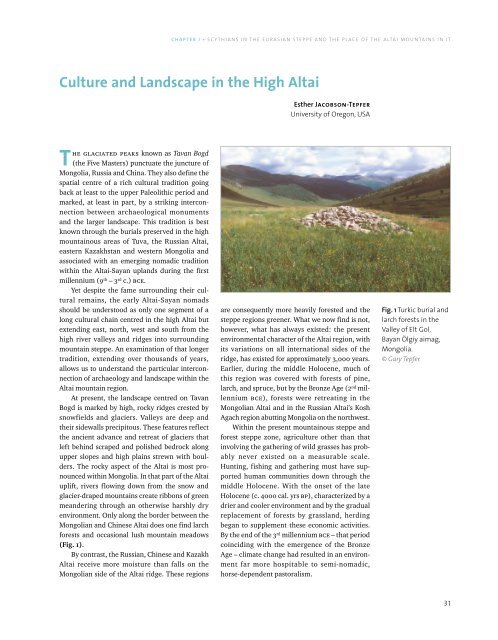Scythian Culture - Preservation of The Frozen Tombs of The Altai Mountains (UNESCO)
You also want an ePaper? Increase the reach of your titles
YUMPU automatically turns print PDFs into web optimized ePapers that Google loves.
CHAPTER I • SCYTHIANS IN THE EURASIAN STEPPE AND THE PLACE OF THE ALTAI MOUNTAINS IN IT<br />
<strong>Culture</strong> and Landscape in the High <strong>Altai</strong><br />
Esther Jacobson-Tepfer<br />
University <strong>of</strong> Oregon, USA<br />
<strong>The</strong> glaciated peaks known as Tavan Bogd<br />
(the Five Masters) punctuate the juncture <strong>of</strong><br />
Mongolia, Russia and China. <strong>The</strong>y also define the<br />
spatial centre <strong>of</strong> a rich cultural tradition going<br />
back at least to the upper Paleolithic period and<br />
marked, at least in part, by a striking interconnection<br />
between archaeological monuments<br />
and the larger landscape. This tradition is best<br />
known through the burials preserved in the high<br />
mountainous areas <strong>of</strong> Tuva, the Russian <strong>Altai</strong>,<br />
eastern Kazakhstan and western Mongolia and<br />
associated with an emerging nomadic tradition<br />
within the <strong>Altai</strong>-Sayan uplands during the first<br />
millennium (9 th – 3 rd c.) bce.<br />
Yet despite the fame surrounding their cultural<br />
remains, the early <strong>Altai</strong>-Sayan nomads<br />
should be understood as only one segment <strong>of</strong> a<br />
long cultural chain centred in the high <strong>Altai</strong> but<br />
extending east, north, west and south from the<br />
high river valleys and ridges into surrounding<br />
mountain steppe. An examination <strong>of</strong> that longer<br />
tradition, extending over thousands <strong>of</strong> years,<br />
allows us to understand the particular interconnection<br />
<strong>of</strong> archaeology and landscape within the<br />
<strong>Altai</strong> mountain region.<br />
At present, the landscape centred on Tavan<br />
Bogd is marked by high, rocky ridges crested by<br />
snowfields and glaciers. Valleys are deep and<br />
their sidewalls precipitous. <strong>The</strong>se features reflect<br />
the ancient advance and retreat <strong>of</strong> glaciers that<br />
left behind scraped and polished bedrock along<br />
upper slopes and high plains strewn with boulders.<br />
<strong>The</strong> rocky aspect <strong>of</strong> the <strong>Altai</strong> is most pronounced<br />
within Mongolia. In that part <strong>of</strong> the <strong>Altai</strong><br />
uplift, rivers flowing down from the snow and<br />
glacier-draped mountains create ribbons <strong>of</strong> green<br />
meandering through an otherwise harshly dry<br />
environment. Only along the border between the<br />
Mongolian and Chinese <strong>Altai</strong> does one find larch<br />
forests and occasional lush mountain meadows<br />
(Fig. 1).<br />
By contrast, the Russian, Chinese and Kazakh<br />
<strong>Altai</strong> receive more moisture than falls on the<br />
Mongolian side <strong>of</strong> the <strong>Altai</strong> ridge. <strong>The</strong>se regions<br />
are consequently more heavily forested and the<br />
steppe regions greener. What we now find is not,<br />
however, what has always existed: the present<br />
environmental character <strong>of</strong> the <strong>Altai</strong> region, with<br />
its variations on all international sides <strong>of</strong> the<br />
ridge, has existed for approximately 3,000 years.<br />
Earlier, during the middle Holocene, much <strong>of</strong><br />
this region was covered with forests <strong>of</strong> pine,<br />
larch, and spruce, but by the Bronze Age (2 nd millennium<br />
bce), forests were retreating in the<br />
Mongolian <strong>Altai</strong> and in the Russian <strong>Altai</strong>’s Kosh<br />
Agach region abutting Mongolia on the northwest.<br />
Within the present mountainous steppe and<br />
forest steppe zone, agriculture other than that<br />
involving the gathering <strong>of</strong> wild grasses has probably<br />
never existed on a measurable scale.<br />
Hunting, fishing and gathering must have supported<br />
human communities down through the<br />
middle Holocene. With the onset <strong>of</strong> the late<br />
Holocene (c. 4000 cal. yrs bp), characterized by a<br />
drier and cooler environment and by the gradual<br />
replacement <strong>of</strong> forests by grassland, herding<br />
began to supplement these economic activities.<br />
By the end <strong>of</strong> the 3 rd millennium bce – that period<br />
coinciding with the emergence <strong>of</strong> the Bronze<br />
Age – climate change had resulted in an environment<br />
far more hospitable to semi-nomadic,<br />
horse-dependent pastoralism.<br />
Fig.1Turkic burial and<br />
larch forests in the<br />
Valley <strong>of</strong> Elt Gol,<br />
Bayan Ölgiy aimag,<br />
Mongolia.<br />
© Gary Tepfer.<br />
31
















